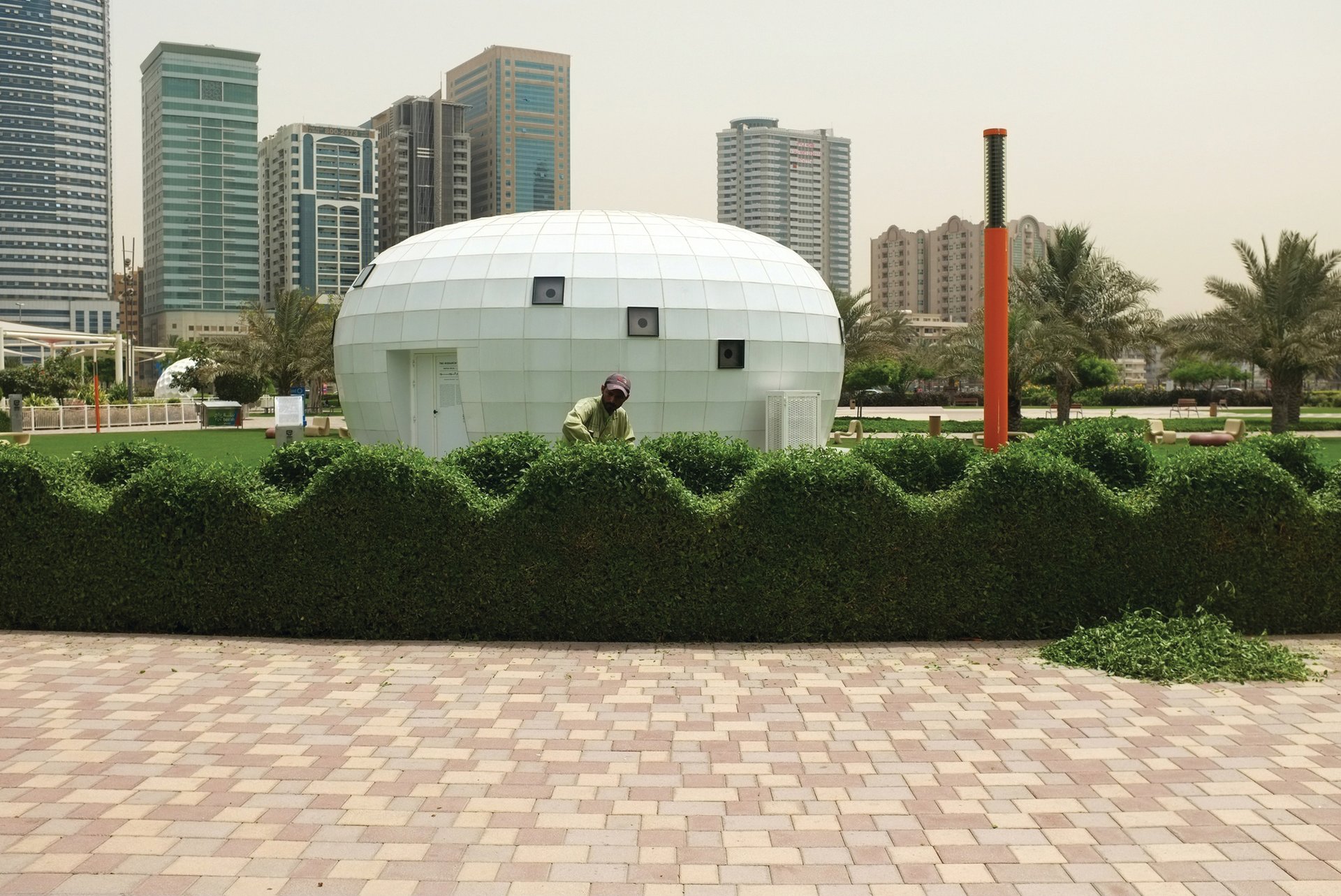So-called emerging artist Vikram Divecha may no longer be quite so emerging. The past year has seen the Dubai-based Indian artist clinch a gallery representation deal with Gallery Isabelle van den Eynde (IVDE), feature in curator Christine Tohmé’s Sharjah Biennial 13 programme and show up on the roster slated for the UAE National Pavilion at the 57th Venice Biennale opening in May. Such validating experiences have not only garnered greater visibility for his works—which have primarily been temporary public pieces—but have also concretised his socially engaged practice in the minds of wider gallery- and fair-going audiences.
Quietly, almost invisibly, Divecha’s works disrupt. He infiltrates what he calls “found processes”— municipal sweepers on their daily clean-up rounds, gardeners responsible for hedge upkeep in a Sharjah park, a children’s toy trader with limited warehouse space—and, by introducing the slightest glitch, creates potent outcomes that call into question the mechanics of the processes themselves. He collaborates with communities, negotiates with bureaucrats, and seemingly gives agency to those who previously had little.
His work with five Sharjah municipal gardeners, Shaping Resistance (2015), for example, involved a series of drawing workshops with his collaborators, resulting in sketchbooks that served as sites of exploration before the workers began reshaping the hedges in their charge according to their own designs. The sketchbooks themselves, images of which are in Divecha’s solo show Minor Work (2017) currently at IVDE (9 March-11 May), raise interesting questions of authorship, agency and visibility.
At the crossroads of formalist preoccupations and (almost) activist impulses, Divecha marries two unlikely trajectories in a city that resonates with the promise of potential—a mix that is now sparking curiosity.

The Art Newspaper: Your works always have a clear link to the real world, to actual social dynamics and the players within economic and labour systems. Why is this so critical to your practice?
Vikram Divecha: Confronting a city—and its resistance—has always been material I’ve grappled with, even when I was growing up in Mumbai. Navigating through bureaucratic structures and negotiating with communities is a reality from which I fabricate work. Short-circuits at specific sites is a manoeuvre that I’ve been exploring through my practice of engagement. Very recently, at IVDE, I introduced my long-term collaborators—the municipal gardeners from Sharjah—as artists and stakeholders.
What is it about working with sites of commerce – such as IVDE – that provokes your interest?
As an urban-based artist who also works to sustain himself, I can’t help but be part of some operation of commerce. Working within these operations, rather than situating myself as an artist working on the periphery, is something I have to accept, if not embrace. I find it difficult to separate questions of survival and commerce from my practice. In The Warehouse Project (2016), for example, I provided a warehouse in Alserkal Avenue, Dubai’s gallery district, to a trader who was in need of extra stock space. The idea of barter was snatched up enthusiastically by the trader. In this case capitalism became generative for both parties, probably best described as a win-win deal in business lingo. The result was a fluctuating sculptural component, as the stacked boxes were constantly altered, determined by market needs. The boxes were so entrenched within commercial realities, just as we sit within a city or a state.
How are you experiencing this transition from large-scale works that exist predominantly in the public space, like Beej (2017), a roundabout in the Sharjah Biennial, to displaying in a gallery?
I’m interested in the idea of sites of improvisation. My works become almost like sites, or situations. Coming back to the Gardeners’ Sketchbooks (2017), the actual sketchbooks themselves are contested objects— they sit with me, but they are the work of the gardeners and we have reproduced them in a series for the current show at the gallery. So it raises questions of authorship, of reproduction, of editions. But these questions can only be raised if I bring the work into the gallery; otherwise they just remain contested objects.
Your work also treads a line of institutional critique. In Sweepers (2016), you rerouted municipal sweepers’ daily paths so they would deposit rubbish bags in front of the Sharjah Art Museum. Can you maintain this critical stance from within the commercial structure of the gallery?
Working for non-profit institutions and then entering a for-profit space is a transition that brings a lot of challenges, but also opens up different possibilities. It has made me think about the gallerist, her space, her team as another form of the material of the city, which in a concentrated way reflects a macro system. So for me, I had to think about inhabiting this space, beyond it being just a container to exhibit work. The foot in the door was through the Gardeners’ Sketchbooks.

Vikram Divecha weighs in on different aspects of his practice.
Sculpture
“I think about my work sculpturally. Even me navigating through a space is a form of sculpture: the people I brush up against, meandering, having encounters-these are all very important forms. Inhabiting a space, even temporarily, is a sculptural act.”
Texture
“The abrasiveness of the city, the layers of bureaucracy and the unpredictability of the next encounter—all these form an amazing surface I want to navigate. These are only available the moment you step out of the studio.”
Studio
“Studios are for me transitory sites that are constantly available in the city—construction sites, trading houses, art galleries, and so on. They come with material, space, an expertise and aesthetic that has been fine-tuned in the service of capitalism.”



